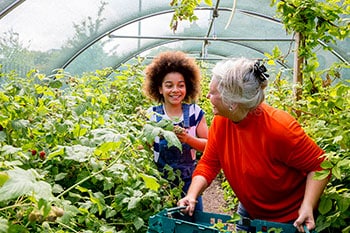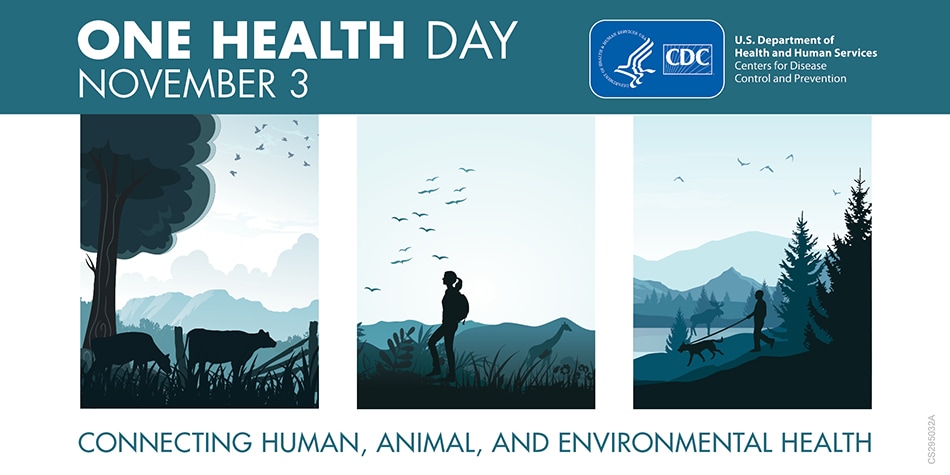Working Together for One Health

One Health is the idea that the health of people is connected to the health of animals and our shared environment. Learn why One Health is important and how, by working together, we can achieve the best health for everyone.
We’re All Connected
Did you know that animals and humans often can be affected by many of the same diseases and environmental issues? Some diseases, called zoonotic diseases, can be spread between animals and people. More than half of all infections people can get can be spread by animals – a few examples include rabies, Salmonella, and West Nile virus. Environmental issues like harmful algal blooms or lead contamination also can affect the health of both people and animals. Antimicrobial resistance is another emerging threat to the health of people and animals, and resistant germs often spread through our shared environment.
As Earth’s population grows, our connection with animals and the environment changes: people live closer together, travel more often around the globe, alter the environment, and have different relationships with animals for companionship, education, food, and more. All of these changes can make it easier for diseases to spread between animals and people. Because of these interactions, animals also can sometimes serve as early warning signals of potential human outbreaks. Tracking diseases in animals helps to keep domestic and wild animals healthy, and also can help prevent illnesses and disease outbreaks in people.
- Salmonella infections have been linked to contact with live poultry in backyard flocks, pet guinea pigs, reptiles like lizards and turtles, as well as other pets. People can get sick with Salmonella by touching these animals or through contact with the animal’s environment, including coops, cages, and other habitats.
- Wild water birds are hosts to many Influenza A viruses that do not normally infect people but can infect and spread among domestic poultry. Some of these bird viruses can be passed to humans through contact with infected animals or virus contaminated environments. Avian influenza A (H7N9) and H5N1 viruses are examples of bird flu viruses that are known to infect people. Other influenza A viruses also infect and spread in pigs, and there have been sporadic infections in people with these viruses.
- Rift Valley fever (RVF) is caused by a virus that is spread by mosquitoes, and has caused multiple outbreaks in Africa and the Middle East. People can get RVF from bites of infected mosquitoes, but more commonly people are infected through contact with blood, body fluids, or tissues of infected animals, mainly livestock. RVF can cause serious disease in both people and animals. Vaccinating animals can help protect people while also protecting the animals they rely on for food and as a source of income.
- Harmful algal bloom (HAB)-related illnesses can occur when algae and other plant-like organisms in water produce toxins. Algal blooms can occur in fresh, brackish, and salt water, and they become HABs when the algae grow quickly and can harm animals, people, or the environment.
One Health Involves Everyone

Experts and the community can work together to support One Health.
A One Health approach to public health involves many experts working together to improve the health of people, animals — including pets, livestock, and wildlife — and the environment. Common types of professionals involved in One Health work include disease detectives, laboratorians, human healthcare providers, veterinarians, physicians, nurses, scientists, ecologists, and policy makers. However, One Health issues can affect everyone, from pet owners, travelers, and farmers to anyone who buys and eats food or drinks or swims in water.
Partnerships and communication between experts in animal, human, and environmental health are an essential part of the One Health approach. A One Health approach can also include other partners and organizations working on shared health threats. Working together allows us to have the biggest impact on improving health for both people and animals. CDC has partners in the United States and around the world, all working together to keep people healthy and educated about One Health. From researching sick sea otters in California, to developing an app for farmers to track illness in animal herds, much of the One Health work being done around the world is dependent on agencies and organizations supporting each other and sharing resources and knowledge. All of this work can help to predict, prevent, and control zoonotic disease outbreaks that threaten human and animal health, and can address other threats that affect humans, animals, and our shared environment.
How You Can Help

November 3 is One Health Day! This is a day to celebrate and bring attention to the One Health concept. Education and awareness events are held all around the world and provide people a chance to see One Health in action. One Health Day brings people together in support of achieving the best health for all people, animals, and the environment!
You can be a One Health hero by taking steps to prevent diseases spread between animals and people.
- Practice healthy pet habits.
- In the United States, pets and other animals such as backyard poultry are often the source of disease outbreaks in people. To stay healthy, take steps to make sure your pet stays healthy and practice good hygiene around your pets.
- Keep wildlife wild.
- Enjoy wildlife from a distance to reduce the risk of illness and injury to you, your pets, and wild animals.
- Professionals in many fields, especially human health care, veterinary medicine, public health, animal health, and environmental health, can use a One Health approach.
- Professionals should recognize the connection between human health, animal health, and the environment, and work together to achieve the best health for all.






















.png)











No hay comentarios:
Publicar un comentario